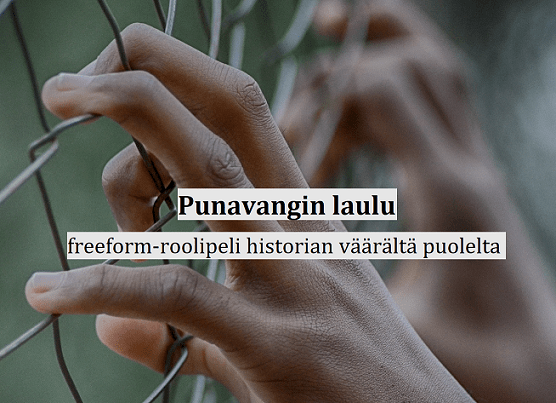I’m on a study project to improve my understanding of roleplaying games. To this end, I already have two reading projects, A Game Per Year and An Adventure Per Year. This is the third, with the goal of reading or playing 52 games made this year or last year. Originally I considered making this “A New RPG Per Week” and that’s where the number 52 comes from, even though a weekly schedule is probably not within my abilities.

Song of a Red Prisoner (Punavangin laulu) is a freeform roleplaying scenario by the Finnish designer Minna Heimola. It’s about the experiences of red prisoners in the aftermath of the Finnish civil war in 1918.
The war was fought between the socialist reds and the right wing whites. The whites won and interred large numbers of red prisoners in prison camps that were the site of numerous atrocities. Although the civil war was over a hundred years ago, you still see right winger commentators trying to argue that the mass executions, starvation and rape were in some way necessary.
Heimola’s scenario is a simple, elegant design based on a preplanned list of scenes of life at the Hennala prison camp. The design style resembles chamber larp and Fastaval-style compact tabletop scenarios.
The ten characters of the game are drawn from different types of people who were in the Red Brigades, from ideologues to those who were in it just for pay and food. Characters from the women’s “Pants Brigades” (naisten housukaarti) are also included.
The substance of the design is in the list of scenes and the details of the characters. The characters in particular carry a lot of the basic humanity on which the scenario is built on. They are ordinary people, very relatable in their concerns and quirks. They are not martyrs or heroes, just individuals doing the best they can in horrible circumstances.
The serious historical subject matter is best seen in the context of Finnish political larp. In an interview, Heimola mentions the trilogy Siikalahti (1918) as a particular source of inspiration. The larps chronicle the events of the civil war in the town of Siikalahti. Although political subject matter is more rare in Finnish tabletop roleplaying games, there are a few instances of that as well, such as the 1996 game Hiljaisuuden vangit (Prisoners of Silence). It’s about life in future fascist Finland.
I found Heimola’s scenario particularly affecting because in the last year or two me and my wife have visited the memorials erected on the sites of some of the worst civil war atrocities. It’s wonderful that this history can be examined in the medium of roleplaying games.